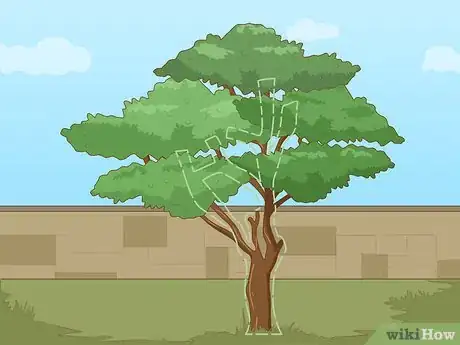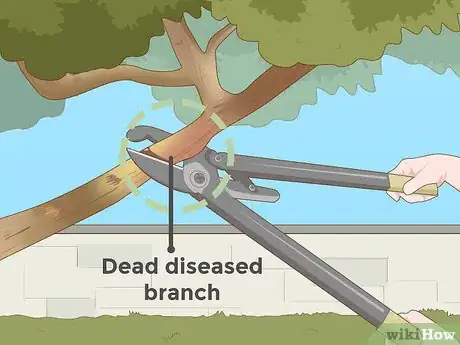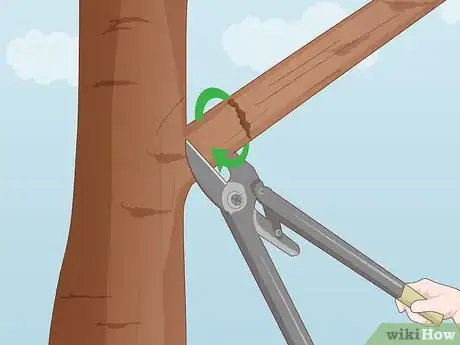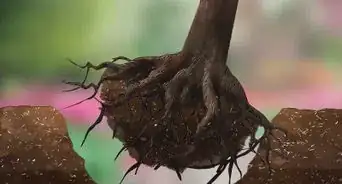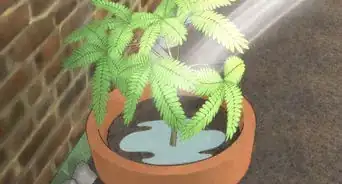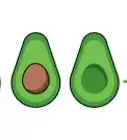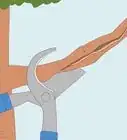This article was co-authored by Andrew Carberry, MPH. Andrew Carberry is a Food Systems Expert and the Senior Program Associate at the Wallace Centere at Winrock International in Little Rock, Arkansas. He has worked in food systems since 2008 and has experience working on farm-to-school projects, food safety programs, and working with local and state coalitions in Arkansas. He is a graduate of the College of William and Mary and holds a Masters degree in public health and nutrition from the University of Tennessee.
wikiHow marks an article as reader-approved once it receives enough positive feedback. In this case, 96% of readers who voted found the article helpful, earning it our reader-approved status.
This article has been viewed 714,260 times.
Pruning helps trees grow strong and look neat and attractive. One prunes a tree to remove damaged branches, allow for new growth or create a distinctive shape. It's important to do it correctly, so you don't end up damaging the tree. Read on to learn the basics.
Steps
Deciding What to Prune
-
1Think about why you want to prune. Are you trying to shape a tree for shade or height? Has the tree been pruned recently? Before you begin, you want to consider what you are trying to achieve and set your goals.[1]
- Your reasons for pruning will influence when you prune as well. You can do light pruning or remove dead wood at any time, but if you have larger goals, you'll want to plan your pruning around the seasons.
- For instance, pruning in the winter will result in an explosion of growth during the spring. Pruning during the summer will slow the growth of the cut branch, so it's a good strategy if you're trying to shape your tree or slow the growth of branches you don't want.
-
2Assess the tree. Spend a few moments looking at the tree's size and shape and imagining how it should look when you are finished.Advertisement
-
3Identify the major branches of the tree that make up its "skeleton." Avoid removal of these branches.[2]
-
4Remove branches that show signs of damage first. Whether they were damaged by a storm or some other event, broken branches should be pruned so that the water and nutrients they're still taking from the tree get redistributed to healthy branches.[3]
-
5Thin out areas that are thick with branches. Remove branches that cross, then open the plant so that air might circulate and light reach all parts of the plant. In order for trees to grow healthy, they need good air circulation through and around the branches. Branches that are close together foster the growth of fungus and attract more insects.
- Eliminate branches that are growing inward, toward the center of the tree. These cause clutter and are not healthy.
-
6Prune branches that act as obstructions. Whether they're low branches blocking your walkway or higher branches threatening your telephone wires, rubbing your roof, or overhang your house. It's fine to prune the branches that are causing some type of annoyance.
-
7Prune branches to help shape the tree. If you'd like your tree to have a more rounded or neat looking shape, prune a few branches that seem to stick out at odd angles; a few cuts will make a big difference.[4]
-
8Prune as little as possible. Each cut you make compromises the tree protection system and opens the tree to potential fungus and insect infestation. Prune only as much as you absolutely need to prune, and never remove more than 25 percent of a tree's branches.
- For most deciduous trees, make sure that there are living branches on at least 2/3 of the tree, though this varies by species. Be aware that the trunk alone is not enough to ensure that the tree will survive. Removing all the branches is highly stressful for the plant.
- Don't prune heavily more than once per season. Unless a storm breaks more branches, you shouldn't prune more than once, since the tree needs time to recover.
Pruning to Minimize Damage
-
1Take out your pruning tools in the dormant season. Pruning during the late fall or early winter puts less stress on the tree, since it minimizes sap loss. Pruning during this time of year is also better for the tree because it's less likely the "wound" you make will get infected by insects or fungus, which are also relatively active in the late fall and early winter.[5]
- A good time marker is to prune after the leaves have fallen off the tree. This means the tree is dormant until early spring.
- If a storm during a different part of the year causes a branch to break, it's OK to prune it immediately instead of waiting for winter.
-
2Make a cut on the underside of the branch. This initial cut shouldn't go all the way through the branch. It is made to prevent the branch from cracking too close to the trunk of the tree when the weight of the branch is ready to fall.[6]
- The cut should be made on the branch side of what is called the stem collar. This is the small lip of bark that each branch protrudes from. You want to leave the collar intact, so don't cut flush with the trunk.
-
3Cut off the branch several inches from the trunk. Your second cut will saw through the branch, on the outside (further from the trunk) of the first cut you made. Remove the branch from the area; what you have left is a stub.[7]
-
4Make a precise cut to remove the stub. Now you can make another cut almost right against the stem collar. This gives the tree the best chance of healing in a quick, healthy way.
- Be sure you don't actually cut off the branch collar. This must remain intact.
-
5Clean your pruning equipment. Although it is probably not necessary to disinfect your pruning equipment if you avoid cutting into cankers and obviously diseased portions of trees, it probably is better to be safe and disinfect your pruning tools with rubbing alcohol (or any household cleaner) after each cut of a diseased tree. You should also dip or rub the blades with a disinfectant impregnated cloth after the pruning of a healthy tree is complete, and before you move to the next tree or bush. Diseases are sometimes spread through dirty pruning equipment and pruning tools.
Our Most Loved Articles & Quizzes
Community Q&A
-
QuestionI have a Lawson's Cyprus tree that needs pruning. Can you help?
 Community AnswerWait until early spring. Start by pruning the most crowded branches and branches that weigh down because of their length and weight. Try to trim the outside line of the tree into a pyramid-like shape if it is alone. In a hedge, you can trim it more severely. Be careful not to cut the top off more than 1/8-1/10 of its total height.
Community AnswerWait until early spring. Start by pruning the most crowded branches and branches that weigh down because of their length and weight. Try to trim the outside line of the tree into a pyramid-like shape if it is alone. In a hedge, you can trim it more severely. Be careful not to cut the top off more than 1/8-1/10 of its total height. -
QuestionHow can I ensure that my tulip tree that had about a third of it ripped off by a summer storm will survive?
 Community AnswerTake extra care and watch it over time. Trim back damaged branches, because they could be getting in the way of further growth. Fertilizer can't hurt, just be sure not to purchase one bad for insects, because the bugs might be helpful. A storm is natural, so nature will take its course.
Community AnswerTake extra care and watch it over time. Trim back damaged branches, because they could be getting in the way of further growth. Fertilizer can't hurt, just be sure not to purchase one bad for insects, because the bugs might be helpful. A storm is natural, so nature will take its course. -
QuestionWhen do I prune to maximize growth?
 Sherwin Llanza Haber EscuroCommunity AnswerOn the plant's growing season, pinch the shoots to encourage thicker growth.
Sherwin Llanza Haber EscuroCommunity AnswerOn the plant's growing season, pinch the shoots to encourage thicker growth.
Warnings
- Prune conifers with caution, particularly if used as a hedging plant. Conifers will only put out new shoots from green wood. So, if the conifer is used as a hedge plant and you prune until it shows no green, that is the way that it will stay.⧼thumbs_response⧽
- Always prune safely. Wear a long sleeve shirt, gloves to protect your hands, and safety goggles to prevent foreign objects from damaging your eyes.⧼thumbs_response⧽
- Do not top shade trees. Topping a tree is pruning it for height - shade trees are meant to grow tall. Topping has serious implications re branch structure/strength and overall tree health. Do not attempt to control the height of a large tree by shearing the top. Plant a different tree instead.⧼thumbs_response⧽
Things You'll Need
- Hand pruners (for small, thin branches)
- Loppers
- Hand saw
- Pole saw (for hard-to-reach branches)
- Ladder
- Cleaning agent (e.g. isopropyl alcohol)
References
- ↑ https://www.arborday.org/trees/tips/when-to-prune.cfm
- ↑ https://www.treesaregood.org/treeowner/pruningyourtrees
- ↑ https://www.bhg.com/gardening/trees-shrubs-vines/care/how-to-prune-trees/
- ↑ https://extension.umn.edu/planting-and-growing-guides/pruning-trees-and-shrubs
- ↑ https://extension.umn.edu/planting-and-growing-guides/pruning-trees-and-shrubs#use-the-right-tools-for-pruning-1336765
- ↑ https://www.bhg.com/gardening/trees-shrubs-vines/care/how-to-prune-trees/
- ↑ https://www.bhg.com/gardening/trees-shrubs-vines/care/how-to-prune-trees/
About This Article
Pruning a tree can improve its appearance, prevent pests and disease, and help the tree grow strong and healthy. The best time to prune a tree is during the dormant season, or late winter through early spring. You’ll need pruning shears to cut branches less than 1 inch (2.5 cm) in diameter and a hand saw to remove branches up to 4 inches (10 cm) in diameter. For thicker branches, you can use a small chainsaw. When pruning, aim to remove any dead, broken, or diseased branches, as well as any downward-growing limbs or branches that are entangled or crossed. Remove any suckers, which look like small stems, that grow up from the ground or base of the trunk. You should also remove any branches that are bigger in diameter than the trunk. Thin some of the branches in an overcrowded tree to allow more light and air to reach the crown. You can also remove lower branches to raise the crown if you need more clearance under the tree. Cut close to the branch collar, the swollen area at the base of the branch, when pruning. Properly pruning young trees is especially important so they grow to be healthy and well structured. Prune back any crossing branches or branches that grow in toward the middle of a young tree, and cut off lower branches on the trunk as the tree grows to raise the crown. Avoid cutting the leader, or the vertical stem at the very top of the trunk, on a young tree. Some types of trees require special care when pruning to prevent disease, pests, and growing problems, so always research your tree's specific requirements before pruning it. For tips on how to make cuts without damaging your tree, read on!


